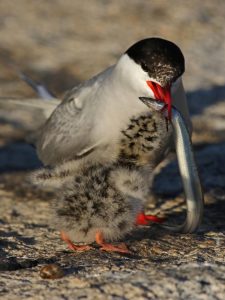Since 1950 globally monitored seabird populations have declined significantly, with possible causal factors including plastic…

An Examination of Common, Arctic, Roseate, and Least Terns Diets in a Changing Climate in the Gulf of Maine

Keenan Yakola, a Masters student at the University of Massachusetts Amherst and a fellow with the DOI Northeast Climate Adaptation Science Center, completed his thesis evaluating chick diets of Common, Arctic, Least and Roseate Terns on seven seabird colonies (Matinicus Rock, Eastern Egg Rock, Jenny Island, Outer Green Island, Stratton Island, Seal Island NWR, Pond Island NWR) in the Gulf of Maine, USA. Provisioning data was collected over a 32 period (1986 and 2017) and evaluated to: 1) quantify and compare dietary differences among tern species; 2) discern spatial and temporal differences in foraging ecology across the region, 3) characterize long-term dietary trends across nesting islands, 4) describe within-season dietary phenology, and 5) quantify how climate change influences dietary patterns. Findings suggest there are significant differences in diets among tern species and islands; however, three prey groups (hake, sand lance and herring) comprise the majority of chick diet for all terns and islands. The reliance on a few prey items led to narrow foraging niches, potentially increasing their vulnerability to climate change, fisheries practices, or other localized disturbances. Over time there was a declining trend in the occurrence of hake and increasing amounts of sand lance in Common tern diets. In addition, hake and sand lance occur with higher frequency earlier in the season, while butterfish and a variety of other fish (historically of lower importance) showed the opposite trend. Furthermore, results indicated that the within-season decline of hake occurs more rapidly in years with earlier spring onset, potentially indicating a phenological shift. Finally, warming sea surface temperatures were found to be negatively correlated with hake and positively correlated with the “other fish” prey group. Results from this project identify forage fish species that support the long-term sustainability of regional tern populations and provide insights on how climate change is altering the availability of forage resources to seabirds nesting in the Gulf of Maine. The islands included in this study are managed and data collection is managed by the National Audubon Seabird Restoration Program and the Maine Coastal Islands NWR who are collaborators on this project.
Products & References:
Yakola, K. 2019. An examination of tern diets in a changing Gulf of Maine. University of Massachusetts Amherst. Masters Thesis. 104 p.
Yakola, K., A. Jordaan, S. Kress, P. Shannon, M.D. Staudinger. In preparation. Inter and intraspecific comparisons of tern chick diet across seven nesting colonies in the Gulf of Maine, USA. Anticipated submission to The Auk November 2019.
Contact: Michelle D. Staudinger, DOI Northeast Climate Science Center, mstaudinger@usgs.gov



